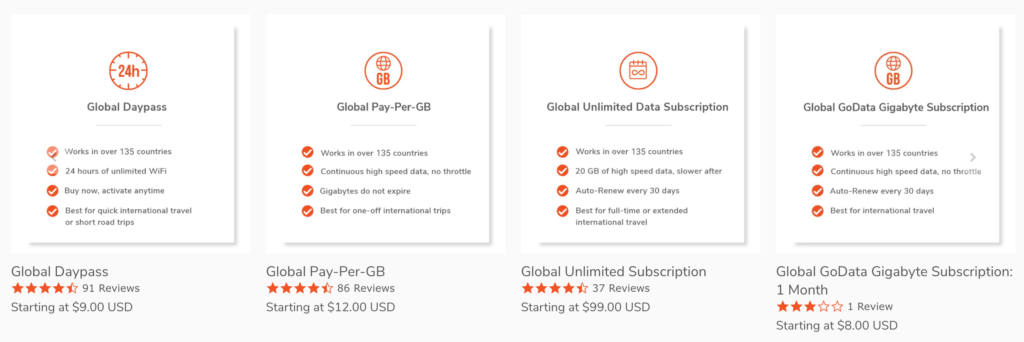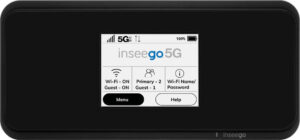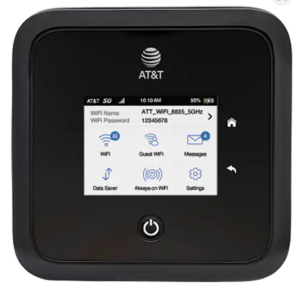These are our picks for the best mobile hotspot devices on the market today.
Best Mobile Hotspot Devices
If you want fast, reliable, and affordable internet on the go, then a dedicated hotspot device is the way to go. Your smartphone just won’t cut it (it will drain your battery, your mobile hotspot data, and you can’t connect to as many devices).
We’ve done our homework and come up with a list of the best hotspot devices on each of the three big networks. We’ve also thrown in a pick for the best international hotspot. Let’s jump into it.
What to look for in a mobile hotspot
We’ve spent an unhealthy number of hours reading about hotspots. But that means we know a lot about what makes them tick. Here’s a cheat sheet on the important stuff to look for when choosing your hotspot.
- Carrier: Most premium mobile hotspots are tied to a specific carrier. Even for the ones that aren’t, you’ll need to buy a data plan from a cell phone company. So be sure to identify which carrier has the best coverage and performance in your area.
- Network type: Different network types—3G, 4G LTE, 5G etc.—use different bands or frequencies to communicate with your device. Some network types, like 5G, are much faster than others. Although 5G hotspots are pricier than others, the faster speeds and lower latency will be worth it for many people.
- Battery: Your hotspot is worthless if it doesn’t hold a charge. Look for a device with at least an eight hour charge.
- Price: Everyone’s ideal price point is different. Just remember the old adage that you get what you pay for.
- Number of connections: Most modern hotspots can connect to more than one device. But some can connect to 10 while others can go up to 30 or more.
Inseego 5G MiFi M2000: Best for T-Mobile
What we like
We’ve been very impressed with T-Mobile recently. Since its merger with Sprint in 2020, T-Mobile has grown its coverage, added a ton of 5G infrastructure, and kicked up its 4G data speeds. We think the carrier currently has the best overall performance in the industry.
So if you’re looking for a hotspot that packs a punch, T-Mobile is probably the best network to use, and the company’s 5G MiFi M2000 is the best device. Here’s everything we love about this powerful hotspot.
Amazing data speeds
5G networks are the future. If you’re thinking about buying a new device—whether it’s a cell phone, a tablet, or a standalone hotspot—it should probably be 5G ready or it will be outdated pretty fast. The 5G MiFi M2000 is, as the name would suggest, 5G ready.
That means you’ll be equipped to take advantage of T-Mobile’s lightning fast 5G network (it’s actually the biggest and fastest in the country).
One downside (which we’ll talk about more below) is that this hotspot doesn’t support the very fastest mmWave 5G technology. However, this won’t be a problem for most people because mmWave networks are only available in small pockets of the country.
T-Mobile Away: plans and prices
One of the biggest issues with mobile hotspot devices is that you have to get a data plan to go along with them. T-Mobile's mobile hotspot plans range from $110 to $160 per month.
Aside from data allotment, both T-Mobile AWAY hotspot plans offer the same benefits—a portable 5G Wi-Fi Gateway device, up to 24 device connections, and no annual contract.
Why not upgrade your phone while you're at it? 5G isn’t just for hotspot. You can also tap into super-fast network speeds with a new phone. You can see all the best prices on the latest phones on our deals page.
Supports Wi-Fi 6 and up to 30 connections
It’s not just the network that determines your data speeds on a hotspot. You also need to consider the connection between your two devices. In this case, you won’t have much to worry about because the MiFi M2000 uses Wi-Fi 6.
This means you’ll get faster data transfer, fewer connectivity issues, and a better battery life. You’ll be able to connect up to 30 devices simultaneously (that’s a lot).
What we don’t like
The 5G MiFi M2000 may be the most powerful hotspot on the market right now. But that doesn’t mean it’s perfect. Here are a few of the problems we noticed.
It’s pricey
T-Mobile’s website lists this hotspot at $399.99—that’s a lot of dough.
Of course, you’ll be able to take advantage of discounts (like the 50% off deal we mentioned above) if you sign up for a payment plan with T-Mobile. But still, that’s a lot of your hard earned money.
T-Mobile doesn’t have the best rural coverage
T-Mobile’s data speeds are top-notch and it’s 5G coverage is outpacing competitors. But when it comes to just raw coverage area, it’s actually in last place. You’ll notice wide coverage gaps in parts of the rural west, like Idaho, New Mexico, and Nevada.
Take a look at this coverage map to see how the network looks in your area.
No mmWave 5G connection
As we mentioned above, this Inseego mobile hotspot device doesn’t work on mmWave 5G networks. Millimeter wave is the fastest type of 5G technology, but because it requires such a high concentration of high-wave towers to operate, it isn’t available in many areas yet.
Most people won’t miss out here, since they aren’t covered by a mmWave network anyway. However, some folks (especially in urban areas) may be disappointed by this omission.
Alternative picks
T-Mobile has several portable hotspot devices to choose from. So, if the MiFi M2000 is looking a little bit pricey then you might want to check out the more affordable Alcatel LINKZONE 2 or the Franklin T9.
While there are several issues that make these cheaper devices less powerful than the MiFi, the biggest difference is that they don’t support 5G. You’ll be stuck on the slower 3G and 4G networks.
Nighthawk 5G Mobile Hotspot Pro: Best for AT&T
What we like
AT&T has upped its game to give us a hotspot device with incredible speeds and top-notch features. And it has an affordable data plan, to boot.
Here’s a closer look at everything we love about the Nighthawk 5G Mobile Hotspot Pro.
Incredible data speeds
This hotspot has everything you need to take advantage of AT&T’s great data speeds. We’ll talk more about its 5G capability in a moment, but even when you’re on AT&T’s 4G network, you should see speeds of around 30+ Mbps. This is plenty for streaming music and video, downloading files, light gaming, and Zooming into a meeting.
$55 for 50 GB of AT&T data
Hotspot’s go cold quickly when you don’t have enough data. With AT&T’s 50 GB plan you should have plenty of high-speed data for all of your streaming, scrolling, and gaming needs.
And it only costs $55 a month.
If you want more data, you can pay for extra data at $10 per 5GB or upgrade your plan to AT&T's 100GB plan for $90 a month.
Supports all 5G network types and Wi-Fi 6
We talked about mmWave 5G speeds a little bit above because T-Mobile’s Inseego 5G MiFi M2000 device doesn’t support this technology. But AT&T’s Nighthawk does, which means you will see data speeds up to 300+ Mbps (that’s probably faster than your home internet).
Of course, mmWave 5G networks are only available in a handful of cities (and specific venues, like airports). If you live in one of these areas you’ll have an amazing hotspot experience with AT&T’s Nighthawk 5G.
But it’s not just 5G that gives this hotspot its speed. It also uses Wi-Fi 6 technology for seamless and rapid data transfer.
What we don’t like
The Nighthawk hotspot is a powerful piece of equipment, but we’re not going to sugarcoat the flaws. Here’s what we aren’t super jazzed about.
$500 price tag
We’re talking about the best of the best mobile hotspots in this article, so none of them are cheap, per se. But the Nighthawk 5G Mobile Hotspot Pro costs a clean $500, and that’s a lot, even for a top-of-the-line device.
AT&T’s 5G network is limited
The biggest problem with investing in a pricey 5G device like this one is that carriers don’t really have their 5G networks up and running in many parts of the country. This is especially true for high-band mmWave 5G, which is only in very select neighborhoods.
You can check out how AT&T’s 5G network coverage looks in your area by using this handy map.
Alternative picks
If you’re not ready to drop close to $300 on a 5G device, there are other options from AT&T. The Nighthawk LTE and the Unite Express 2 are both significantly cheaper (but you’ll only get 3G and 4G network connection).
Having a hard time deciding which carrier is right for you?
We’ve written up some articles to help you figure out which of the Big 3 networks is the best by seeing them go head-to-head. Check ‘em out!
Inseego MiFi M2100 5G UW: Best for Verizon
What we like
Yes, this Verizon hotspot sounds a lot like the T-Mobile device we featured above. But no, they’re not the same. While this Inseego hotspot is similar in many ways, there are a couple of important differences that we’ll cover here.
Let’s start with the good stuff.
Fast 4G and 5G speeds
Like the other hotspots on this list, the biggest selling point for the Inseego MiFi M2100 5G UW is speed. You’ll be able to take advantage of Verizon’s enormous 4G LTE network and its expanding 5G network to get high-speed internet in many parts of the country.
While this hotspot is technically capable of going up to 2.5 Gbps of speed (ludicrously fast), you’re more likely to see speeds of 30-100 Mbps (pretty fast), depending on where you are.
In some rural areas your speeds could be much lower.
Multiple robust data plans from Verizon
Of all the hotspots in this article, this one probably has the best available data plans.
You can get from 15-150 GB of data for $20-80. That leaves plenty of options for different kinds of users, and the 150 GB hotspot plan gives you more than T-Mobile or AT&T do on their top-tier hotspot plans.

Source: Verizon
Verizon’s 100 GB plan is pricier than the others we’ve featured in this article, but it will be worth it for those who need the best rural coverage.
What about prepaid hotspots?
You may have noticed that we’ve focused on the big carriers in this article. We think these carriers offer the best hotspots and hotspot data plans. But there are some other hotspot plans out there from MVNO carriers, like Metro, Straight Talk, and Cricket.
Supports mmWave 5G
This is one of the biggest differences between this device andt the T-Mobile 5G MiFi M2000. With Verizon’s hotspot you can connect to all types of 5G.
While this won’t affect most people because Verizon has such a small mmWave 5G footprint, it will be more of an issue in the future as these networks expand.
What we don’t like
Here’s our favorite part, the part where we whine about all the stuff that isn’t perfect. Let the complaining begin!
$400 retail price
If you opt to pay the full retail price for MiFi 2100 it will run you about $400. That’s about half the price of a new smartphone, but it doesn’t come with a camera, an HD screen, a bunch of apps, or the ability to make calls.
This hotspot is available on a payment plan through Verizon, which will make it seem cheaper. But in the end, you still end up paying the same amount (or more). That’s just the cost of a premium 5G hotspot.
Verizon’s limited 5G coverage
Your fancy new 5G hotspot won’t do you much good if there’s no 5G network to connect to, which brings us to another issue with this device.
Verizon’s 5G network is not the biggest or the fastest. Where it does have 5G, it’s mostly low-band, which is significantly slower than a mmWave high-band network.
But the silver lining is that Verizon is sure to expand its 5G network in the future. You can peep the coverage map below to see how the carrier is looking in your area.
Alternative picks
As with the other carriers on this list, Verizon offers some lower cost alternatives, named the Jetpack MiFi 8800L (which previously held the spot for best Verizon hotspot) and the Verizon Orbic Speed Mobile Hotspot. The biggest thing you’ll lose out on with these devices is 5G connectivity.
Skyroam Solis Lite: Best International Hotspot
What we like
The three devices we featured above will give you amazing coverage in the United States. But if you’re planning a European backpacking trip, a vacation in Thailand, a job in Kenya, or any other foreign adventure, the Skyroam Solis Light is the best hotspot for you.
Here’s what we like best about this device.
Works in 130+ countries
Unlike hotspots from US-based carriers—like Verizon and AT&T—the Skyroam hotspot can connect to a number of different networks in over 130 different countries in Europe, Asia, the Middle East, Africa, and the Americas. Once you’re connected to the local network you can easily set up a Wi-Fi hotspot and connect up to ten other devices.
You can see a complete list of the countries where Skyroam has coverage on the company’s website.
Interested in an international cell phone plan? You can learn all about the best mobile deals for travelers, whether it's for business or pleasure, in our international plans review.
Very affordable at around $140
You can buy the Skyroam Solis Lite for around $140 from a number of retailers, including Amazon and Target.
This makes it a whole lot cheaper than any of the 5G hotspots listed in this review. The biggest cost issue with this device is the data, but we’ll talk about that more in a moment.
Decently priced data plans
If you’ve ever accidently used your phone when you were connected to a foreign network then you know that international roaming costs can add up fast.
As you may expect, Skyroam’s data prices are a bit steeper than the domestic hotspot, but we think they are pretty fair, especially when you consider the alternative.
Skyroam offers four different global data options: daypass, pay-as-you-go, unlimited data, and monthly.
You can see these plans below.

Source: Skyroam
We think that the $99 monthly plan is the best deal by far if you plan to be away for more than a week. But it all depends on how much data you plan to use.
What we don’t like
As always, we have a couple of things to gripe about with the Skyroam hotspot. Here’s where it falls short.
Doesn’t work on 5G
You may have noticed that 5G is the shiny new prize in mobile technology. We’ve been talking about it a lot. Unfortunately, this hotspot is not 5G capable. That means you’ll only have access to 3G and 4G LTE speeds.
For many, this will be fine, especially since 5G is just getting started in the US and doesn’t exist at all in many countries. People have been using hotspots with 4G speeds (think 20-60 Mbps) with no issues, for years.
Less reliable coverage overall
One of the biggest complaints that we see about the Skyroam Solis Lite is the spotty coverage.
Because this one device connects to over 300 different cellular networks in multiple countries, it’s understandably spotty at times. You may see great 4G speeds in one area and then get sluggish 3G speeds in another.
This isn’t totally Skyroam’s fault. Some areas just have worse coverage, and even if you were to get a local phone plan you’d still have issues.
Alternative picks
Honestly, your phone is probably the best alternative to the Skyroam Solis Lite. Most modern smartphones allow you to set up a mobile hotspot.
Check with your carrier to see if they offer international plans or add-ons, so that you can get data while you’re abroad and then tether to your computer or other device.
Recap: Which hotspot is right for you?
Here’s a quick review of the most important points to help you decide which device is right for you.
- Inseego 5G MiFi M2000: This T-Mobile hotspot offers 5G data speeds, affordable data plans, and reliable coverage in the US. The drawbacks are the price and the lack of mmWave 5G connectivity.
- Nighthawk 5G Mobile Hotspot Pro: Those who want to be on AT&T’s network should be pleased with this super-powered hotspot. It can connect to high and low-band 5G and you can get a ton of data for a decent price. The biggest issue is the device’s $400 price tag.
- Inseego MiFi M2100 5G UW: This Verizon hotspot may look like T-mobile’s, but there are some differences. For one, this device can connect to mmWave 5G. The problem is that Verizon doesn’t really have a high-band 5G network to use in most places.
- Skyroam Solis Lite: This affordable hotspot can be used in over 300 different countries, although the strength of coverage varies widely from place to place. The data is a bit pricier than we’d like, but international plans have always been pricey.
Methodology
We spent over a dozen hours researching the hotspot devices listed in this article (as well as many others that didn’t make the list). Our analysis was informed by customer reviews, articles written by experts, and our own speed/coverage data from over 100,000 customers.
We gave special weight to 5G capable devices in this article because it is the next and fastest generation of mobile technology that is becoming the new standard. We also focused on the three major US carriers—AT&T, T-Mobile, and Verizon—because they offer the most robust hotspot plans and devices.
Related Articles









